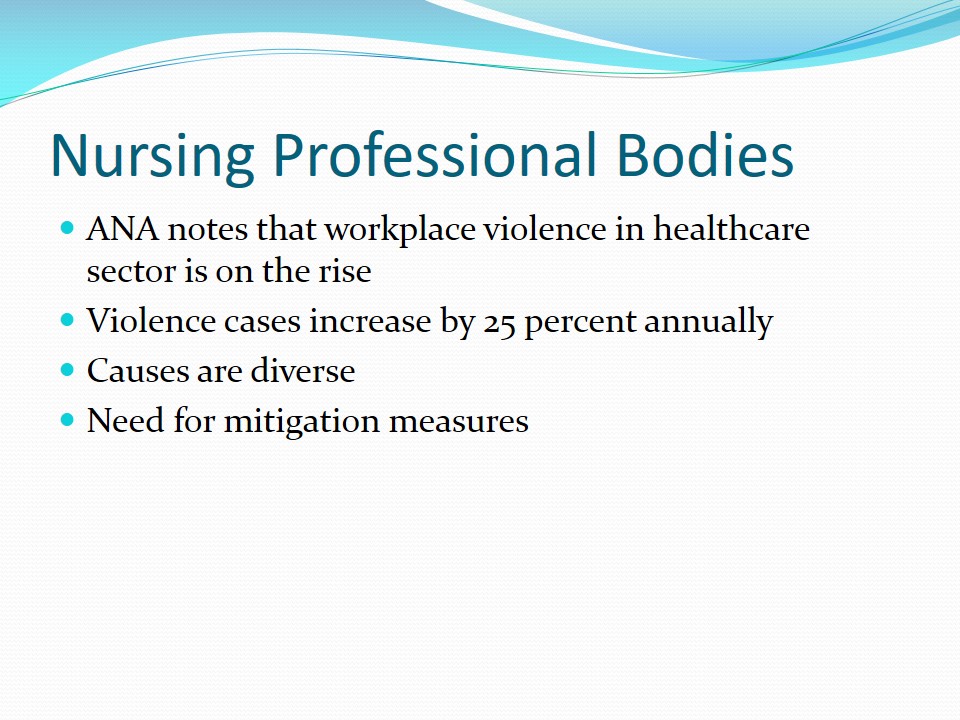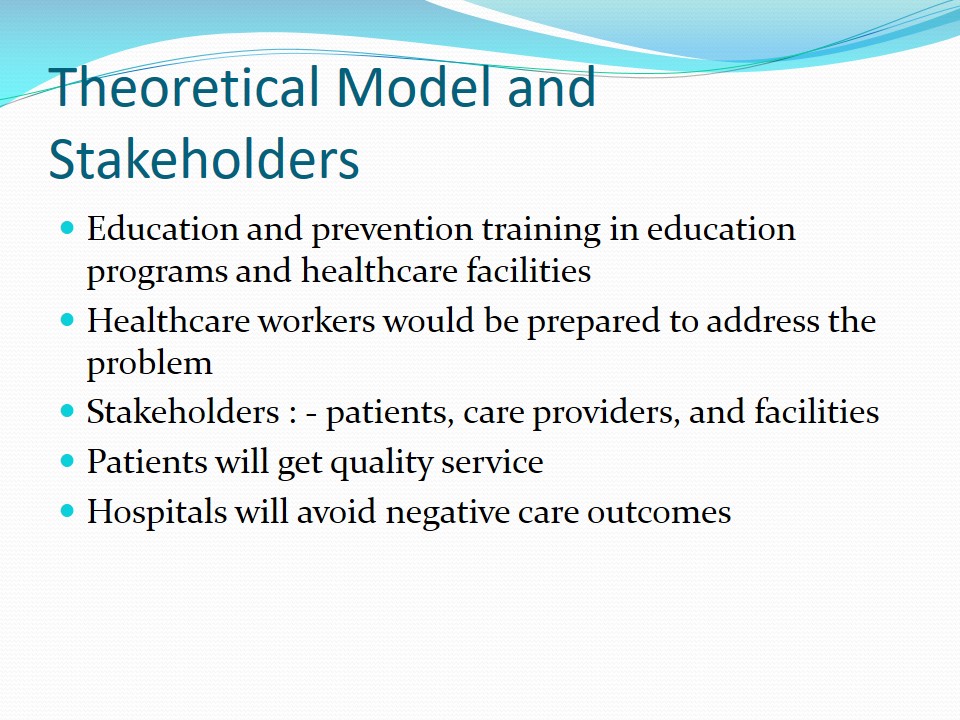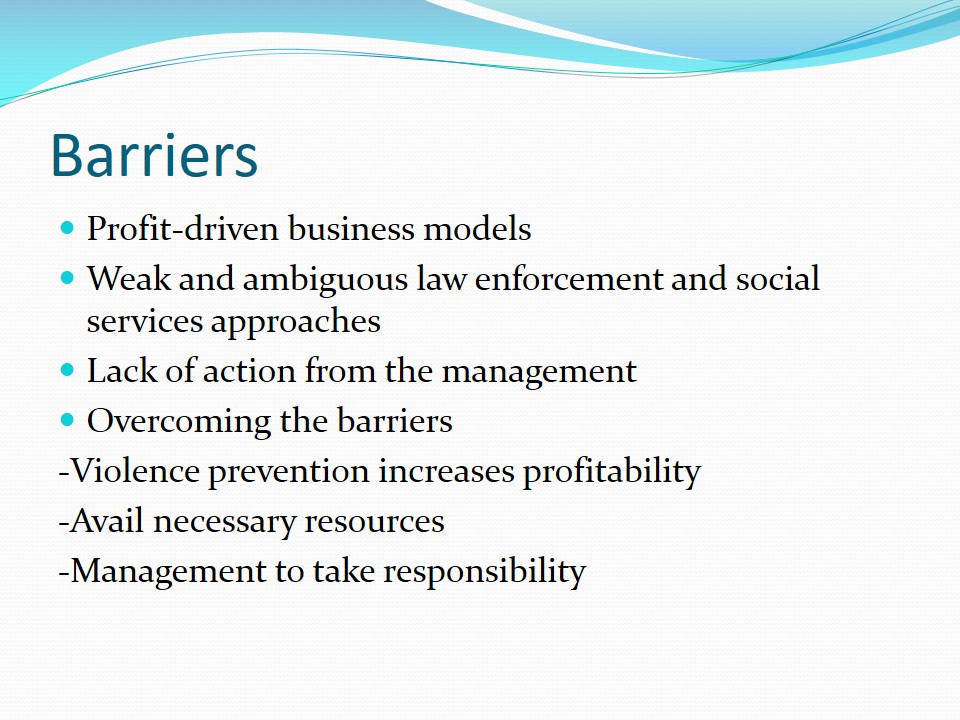Current Risks
- All forms of violence towards care providers.
- Direct or indirect mode of perpetration.
- Physical assaults or threats of assault.
- Risks involve physical, emotional, and psychological harm.
- Care providers’ service delivery is affected.
- Leads to negative healthcare outcomes.
According to the National Institute for Occupational Safety and Health (NIOSH), workplace violence includes all violent acts directed towards healthcare providers including physical assault or threat of assault in the course of performing their duties (Sharp, 2015). Such acts may involve threatening gestures, verbal threats, puling hair, spitting, hitting, and all other forms of physical aggression. Therefore, healthcare providers face the risk of physical, emotional, and psychological harm from work-related violence. Some healthcare workers have also reported sexual harassment, which is a form of violence. The mode of perpetration might be direct or indirect. Ultimately, the victims of this violence may suffer from physical injuries, depression, or post-traumatic stress disorder (PTSD) (Phillips, 2016). These consequences affect the way care providers deliver services to patients, thus leading to negative health outcomes.

Nursing Professional Bodies
- ANA notes that workplace violence in healthcare sector is on the rise.
- Violence cases increase by 25 percent annually.
- Causes are diverse.
- Need for mitigation measures.
According to the American Nursing Association (ANA) (2015), workplace violence among healthcare providers in the US has been increasing consistently over the years. In 2014, the International Association for Healthcare Security and Safety carried out a study and found that violence among healthcare providers increases by about 25 percent annually (Smith, 2016). The causes of this form of violence are diverse including the rising number patients, increased wait times, few hospitals, and shortage of care providers among other problems. Therefore, there is a need to come up with mitigation measures to ensure that healthcare providers are protected from such violence and prepared to deal with any cases that may come up.

Theoretical Model and Stakeholders
- Education and prevention training in education programs and healthcare facilities.
- Healthcare workers would be prepared to address the problem.
- Stakeholders : – patients, care providers, and facilities.
- Patients will get quality service.
- Hospitals will avoid negative care outcomes.
One of the theoretical or regulatory models that would be applicable to the passage of HR 5223 is the requirement to integrate education and prevention training into education programs and healthcare facilities. This requirement would ensure that healthcare providers are prepared, both tactically and emotionally, to deal with workplace violence, if it arises. Some of the stakeholders who will benefit from the passage of HR 5223 include healthcare workers, patients, and care facilities. Healthcare workers will profit by being adequately prepared to handle such cases without affecting their capacity to deliver quality and timely care. Patients will also gain because they would be handled professionally and receive good care despite directing violence towards their care providers. Care facilities would benefit by avoiding negative care outcomes and costs that may be a result of workers facing violence in the workplace.

Barriers
- Profit-driven business models;
- Weak and ambiguous law enforcement and social services approaches;
- Lack of action from the management;
- Overcoming the barriers:
- Violence prevention increases profitability;
- Avail necessary resources;
- Management to take responsibility.
One of the main barriers to the passage of HR 5223 is profit-driven business models that most hospitals use. Therefore, the proposal to introduce training programs to counter workplace violence may be rejected because it would be costly for the facilities. Another barrier is the weak and ambiguous law enforcement and social services approaches, especially when dealing with people with mental illness. The third barrier is lack of action from the management even after violence cases are reported. To deal with the first barrier, hospital management should be sensitized to acknowledge that workplace violence influences customer satisfaction, turnover rates, and productivity. Therefore, adopting HR 5223 may increase profitability. For the second barrier, public policymakers should avail the necessary resources needed to resolve the problem of workplace violence. The third barrier could be addressed by urging the management to act on the reported cases of violence failure to which the victims may escalate the issue to the regulatory bodies.

References
ANA. (2015). Incivility, bullying, and workplace violence. Web.
Phillips, J. P. (2016). Workplace violence against health care workers in the United States. New England Journal of Medicine,374(17),1661-1669.
Sharp, M. T. (2015). Workplace violence: Assessing risk, promoting safety. Nursing Made Incredibly Easy, 13(1), 42-49.
Smith, T. A. (2016). What every healthcare facility should do now to reduce the potential for workplace violence. Journal of Healthcare Protection Management, 32(1), 41-47.